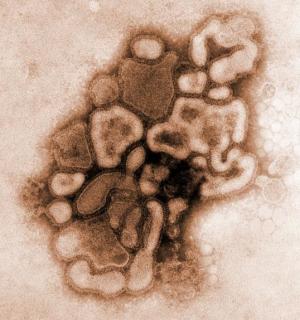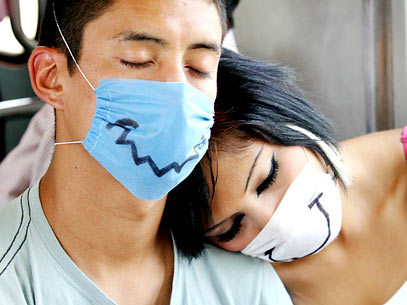
Back around the 2nd of May, 2009 when Twitter had the trending topic of "swine flu" or "h1n1", I got to reading the posts and then started doing some investigative work on my own, only to find that there was a ton of "mis-information" all over the Net. Everything from what the symptoms are to what you could do to protect yourself and your family. What I found was astonishing!
What I didn't see were warning of the dangers of Tamiflu or Relenza or any alternative methods to the CDC and FDA's recommended Tamiflu/Relenza party line.
First, the Danger Zone
I personally believe that we should be given ALL the available information so that we can make sound, informed decisions about what we should, could, or would do.
Let's start with the "standard" line of taking Tamiflu or Relenza if or when you get this H1N1 flu. To start with, there have been zero, nada, zilch studies to the effectiveness of either of these medications to combat this H1N1 flu virus. Next are the adverse side effects that at the end of the commercial they rattle off so many so fast that your brain is turned into mush and you just dismiss them because we've become so desensitized to them they don't even register anymore. For the record, here they are: nausea, diarrhea, stomach upset, chills, fever, achiness, vomiting, and headaches. Doesn't that sound more like the flu than the cure? If you manage to get some, and the rumor is that we will run out long before the vast majority of us get the flu, you'll need to take it within the first 48 hours of the first symptoms, and in doing so, it will shorten the duration of a "normal" flu cycle from 7 days to a mere 5.7 days, a whopping 1.3 day reprieve, which if you're feeling really bad is certainly welcomed to some degree.
How Tamiflu and Relenza works. The drugs in Tamiflu and Relenza are Oseltamivir and Zanamivir respectively. The object is to keep the proteins on the flu virus microbe (the H and N components) from attaching themselves to a healthy cell, injecting its RNA into that cell, turning it into a virus microbe factory. The method the pharmaceutical industry has taken is to get something into the body that will neutralize the associated enzyme that will inactivate the Hemagglutinin or Neuraminidase proteins so that attachment to the cell is now impossible. The side effects come from neutralizing an enzyme that other parts of your body apparently need, upsetting the balance that our Creator put there in the first place.
Then there is the miraculous extension of the expiration date of certain lots of Tamiflu that expired in June 2009, now expiring in 2011. Tamiflu is normally "good" for 36 months, with a vast majority of the stockpiled Tamiflu expiring at the end of June 2009. There is apparently some kind of testing that the FDA has approved to figure out if a "lot" of Tamiflu is still potent or not. After some of this testing, it has been granted that certain lots of Tamiflu will now be good until the end of May 2011. I don't know about you, and I certainly DON'T know the pharmaceutical industry, but if my milk is stated to expire on August 5th, drinking it on August 31st could be a very unpleasant experience.
And of course, the issue of studies. The most recent "study" from a well respected university, Stanford, didn't really do a new study at all, they simply obtained the data collected from 7 previous studies (funded by Big Pharma), combed through the information and has concluded that Tamiflu will NOW prevent the H1N1 flu. Its a generically sweeping statement, that their conclusion is that Tamiflu will prevent the H1N1 flu, but what is left out of that statement is that there were ONLY 2 study groups of people, Caucasians and Japanese, and that they were healthy individuals, all apparently over the age of 18 with no known infirmities or diseases. So if you are under 18 or have asthma, diabetes, cancer, obese, or in any other way infirmed, non-Caucasian and non-Japanese, this study IS NOT conclusive that taking Tamiflu before you get the flu is preventative. And now the CDC is back pedalling and saying NOT to take Tamiflu as a preventative as it may enhance the virus to mutate, which we definitely DO NOT want to see.
Most of what we see flies in the face of science. Science says that we have controlled experiments where duplicable results have been verified. Then the results are published with clear definitions of what they were able to prove. Negative proof such as "Do we know that it DOESN'T prevent the flu in children under 18?" is a negative proof, just because we don't know if it doesn't prevent the flu, a conclusion that it "will" is not possible.
Second, the Landing Zone
To me there is absolutely nothing worse than telling me that I shouldn't do something or that something may be bad for me WITHOUT an alternative.
With a head-to-head against Tamiflu or Relenza, I actually not only found an alternative, but found one that leaves them in the dust.
In the 1990's, an Isreali virologist was commissioned to find a way to prevent the suspected coming virus related pandemics. What she found was TERRIFIC!
We've all heard of the healing power of Elderberries. What the good Doctor found was that in these Black Elderberries is an amino acid called L-Sambucus. What this amino acid does is bind to the proteins (the H and N components) of the flu virus microbe, rendering it unable to attach itself to a cell and starting the microbe manufacturing process that makes you sick. So it has the exact same effect as Oseltamivir or Zanamivir yet without the side effects.
And with the University of Oslo, Norway school of Medicine conducting a study of flu patients, their study showed an incredible shortening of the duration of the flu from 7.1 days to only 3.1 days, that's 4 whole days and cutting the symptoms of the flu by over half. All with NO side effects.
The one caveat of the study is that it wasn't conducted specifically on H1N1 flu patients, so the negative proof also applies here.
In Summary
If you listen to the CDC and the FDA, their recommendation is to get and take Tamiflu or Relenza to prevent or shorten the duration of the upcoming second wave of the H1N1 Flu Pandemic. If you trust the studies and can take the leap that enough information is available that these drugs can and will help you, have at it.
On the other hand, if an amino acid called L-Sambucus has been studied and shown as good or better results with no side effects from a reputable university and you can take the leap that enough information is available that L-Sambucus can and will help you, have at it also.






